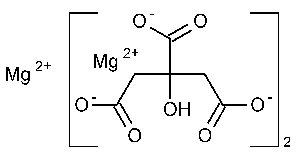Magnesium Citrate Oral Solution
1,2,3-Propanetricarboxylic acid,hydroxy-,magnesium salt (2:3).
Magnesium citrate (3:2) [3344-18-1].
»Magnesium Citrate Oral Solution is a sterilized or pasteurized solution containing,in each 100mL,not less than 7.59g of anhydrous citric acid (C6H8O7)and an amount of magnesium citrate equivalent to not less than 1.55g and not more than 1.9g of magnesium oxide (MgO).
Magnesium Citrate Oral Solution may be prepared as follows:
| Magnesium Carbonate | 15g |
| Anhydrous Citric Acid | 27.4g |
| Syrup | 60mL |
| Talc | 5g |
| Lemon Oil | 0.1mL |
| Potassium Bicarbonate | 2.5g |
| Purified Water,a sufficient quantity, to make |
350mL |
Dissolve the anhydrous Citric Acid in 150mLof hot Purified Water in a suitable dish,slowly add the Magnesium Carbonate,previously mixed with 100mLof Purified Water,and stir until it is dissolved.Then add the Syrup,heat the mixed liquids to the boiling point,immediately add the Lemon Oil,previously triturated with the Talc,and filter the mixture,while hot,into a strong bottle (previously rinsed with boiling Purified Water)of suitable capacity.Add boiled Purified Water to make the product measure 350mL.Use Purified Cotton as a stopper for the bottle,allow to cool,add the Potassium Bicarbonate,and immediately insert the stopper in the bottle securely.Finally,shake the solution occasionally until the Potassium Bicarbonate is dissolved,cap the bottle,and sterilize or pasteurize the solution.
NOTE—An amount (30g)of citric acid containing 1molecule of water of hydration,equivalent to 27.4g of anhydrous citric acid,may be used in the foregoing formula.In this process the 2.5g of potassium bicarbonate may be replaced by 2.1g of sodium bicarbonate,preferably in tablet form.The Oral Solution may be further carbonated by the use of CO2under pressure.
Packaging and storage—
Preserve at controlled room temperature or in a cool place,in bottles containing not less than 200mL.
Identification—
A:
It responds to the tests for Magnesium á191ñ.
B:
To 5mLof Oral Solution add 1mLof potassium permanganate TSand 5mLof mercuric sulfate TS,and heat the solution:a white precipitate is formed.
Chloride á221ñ—
A2.0-mLportion shows no more chloride than corresponds to 0.30mLof 0.020Nhydrochloric acid (0.01%).
Sulfate á221ñ—
A2.0-mLportion shows no more sulfate than corresponds to 0.30mLof 0.020Nsulfuric acid (0.015%).
Tartaric acid—
To 10mLin a test tube add 1mLof glacial acetic acid and 3mLof a solution of potassium acetate (1in 2),shake the mixture vigorously,then gently rub the inner wall of the test tube with a glass rod for a few minutes,and allow to stand for 1hour:no white,crystalline precipitate soluble in 6Nammonium hydroxide is formed.
Assay for anhydrous citric acid—
Measure accurately 10mLof Oral Solution,which previously has been freed from excessive carbon dioxide by repeated pouring,into a 250-mLbeaker,and add 30mLof water.Then add phenolphthalein TSand just enough 1Nsodium hydroxide to give the liquid a persistent pink color,and acidify with 4drops of 1Nhydrochloric acid.Add 20mLof calcium chloride TS,and concentrate,by boiling,to about 30mL,stirring constantly with a rubber-tipped glass rod during the boiling.Completely transfer the precipitate from the hot mixture to a filter of from 9cm to 11cm in diameter with the aid of small quantities of boiling water,then wash the precipitate five times with boiling water.Collect the filtrate and washings in a 150-mLbeaker,and concentrate the solution,by boiling,to about 20mL.Add sufficient 6Nammonium hydroxide,dropwise,to give the liquid a distinct red color,and then concentrate to about 10mL.Transfer the precipitate completely from the hot mixture to a filter of from 7cm to 9cm in diameter with the aid of small quantities of boiling water,and wash the precipitate six times with 5-mLportions of boiling water.
Dry the two filters with the precipitates,and incinerate them together in a loosely covered platinum crucible,heating first at a low temperature until the precipitates are well charred,and then removing the cover and raising the temperature until the residue is nearly white.If a gas flame is used,prevent its contact with the mass in the crucible.Cool,place the crucible with its contents in a suitable beaker,and add about 30mLof water and then 50.0mLof 0.5Nhydrochloric acid VS.When the residue has dissolved,remove the crucible,rinsing it well with water into the beaker.Add 100mLof water,cover the beaker with a watch glass,and boil gently for 10minutes.Cool,and titrate the excess acid with 0.5Nsodium hydroxide VS,using phenolphthalein TSas the indicator.Each mLof 0.5000Nhydrochloric acid is equivalent to 32.02mg of C6H8O7.
Assay for magnesium oxide—
Transfer to a 100-mLvolumetric flask 50.0mLof Oral Solution that has been previously freed from excessive carbon dioxide by repeated pouring.Dilute with water to volume,and mix.Transfer 5.0mLof this solution to a beaker containing 150mLof water heated to 70 to 80
to 80 ,and add 1mLof ammonium chloride TSand then 3mLof ammonium hydroxide.Mix,and add slowly,with stirring,8mLof 8-hydroxyquinoline TS.After standing for 30minutes,filter through a sintered-glass crucible,previously dried and weighed,and wash the precipitate with ten 10-mLportions of water.Dry the crucible and contents at 105
,and add 1mLof ammonium chloride TSand then 3mLof ammonium hydroxide.Mix,and add slowly,with stirring,8mLof 8-hydroxyquinoline TS.After standing for 30minutes,filter through a sintered-glass crucible,previously dried and weighed,and wash the precipitate with ten 10-mLportions of water.Dry the crucible and contents at 105 for 3hours,cool,and weigh.Determine the equivalent of MgOin 100mLof the Oral Solution by multiplying the weight of C18H12MgN2O2·2H2Oso obtained by 4.624.
for 3hours,cool,and weigh.Determine the equivalent of MgOin 100mLof the Oral Solution by multiplying the weight of C18H12MgN2O2·2H2Oso obtained by 4.624.
Auxiliary Information—
Staff Liaison:Elena Gonikberg,Ph.D.,Scientist
Expert Committee:(PA4)Pharmaceutical Analysis 4
USP28–NF23Page 1169
Phone Number:1-301-816-8251
